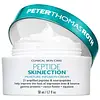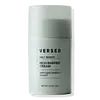What's inside
What's inside
 Key Ingredients
Key Ingredients

 Benefits
Benefits

 Concerns
Concerns

 Ingredients Side-by-side
Ingredients Side-by-side

Water
Skin ConditioningGlycerin
HumectantDimethicone
EmollientOlive Oil Decyl Esters
Glycereth-26
HumectantSqualane
EmollientButylene Glycol
HumectantBehenyl Alcohol
EmollientPolysilicone-11
Batyl Alcohol
EmollientSimmondsia Chinensis Seed Oil
EmollientHexapeptide-11
Skin ConditioningDipeptide Diaminobutyroyl Benzylamide Diacetate
Skin ConditioningPalmitoyl Tripeptide-5
Skin ConditioningTripeptide-10 Citrulline
Skin ConditioningAcetyl Hexapeptide-1
Skin ConditioningAcetyl Tetrapeptide-11
Skin ConditioningAcetyl Hexapeptide-8
HumectantPalmitoyl Hexapeptide-12
Skin ConditioningAcetyl Tetrapeptide-9
Skin ConditioningPalmitoyl Tetrapeptide-7
Skin ConditioningAcetyl Tetrapeptide-2
Skin ConditioningAcetyl Octapeptide-3
HumectantPalmitoyl Hexapeptide-19
Skin ConditioningTrifluoroacetyl Tripeptide-2
Skin ConditioningTripeptide-1
Skin ConditioningPalmitoyl Oligopeptide
CleansingPalmitoyl Tripeptide-1
Skin ConditioningNatto Gum
Sodium Polyglutamate
HumectantSqualene
EmollientMica
Cosmetic ColorantSodium Hyaluronate
HumectantSorbic Acid
PreservativeTocopherol
AntioxidantCereus Grandiflorus Flower Extract
Skin ConditioningPseudoalteromonas Ferment Extract
HumectantLeuconostoc/Radish Root Ferment Filtrate
AntimicrobialMagnesium Chloride
Phenoxyethanol
PreservativeCetyl Alcohol
EmollientStearyl Alcohol
EmollientTrehalose
HumectantGlyceryl Stearate
EmollientSilanetriol Trehalose Ether
EmollientMannitol
HumectantPhytosterols
Skin ConditioningAcrylates/C10-30 Alkyl Acrylate Crosspolymer
Emulsion StabilisingCaprylic/Capric Triglyceride
MaskingHydrogenated Lecithin
EmulsifyingPolyglyceryl-10 Myristate
Skin ConditioningPolysorbate 20
EmulsifyingDimethyl Isosorbide
SolventSodium Benzoate
MaskingPotassium Sorbate
PreservativeCaprylyl Glycol
EmollientSodium Hydroxide
BufferingLaureth-12
EmulsifyingHydrolyzed Wheat Protein
Skin ConditioningLecithin
EmollientDisodium Phosphate
BufferingHydrolyzed Soy Protein
HumectantCarbomer
Emulsion StabilisingDextran
Ethylhexylglycerin
Skin ConditioningSodium Lactate
BufferingTetradecyl Aminobutyroylvalylaminobutyric Urea Trifluoroacetate
Skin ConditioningSodium Phosphate
BufferingXanthan Gum
EmulsifyingTriethanolamine
BufferingAcrylates Copolymer
Water, Glycerin, Dimethicone, Olive Oil Decyl Esters, Glycereth-26, Squalane, Butylene Glycol, Behenyl Alcohol, Polysilicone-11, Batyl Alcohol, Simmondsia Chinensis Seed Oil, Hexapeptide-11, Dipeptide Diaminobutyroyl Benzylamide Diacetate, Palmitoyl Tripeptide-5, Tripeptide-10 Citrulline, Acetyl Hexapeptide-1, Acetyl Tetrapeptide-11, Acetyl Hexapeptide-8, Palmitoyl Hexapeptide-12, Acetyl Tetrapeptide-9, Palmitoyl Tetrapeptide-7, Acetyl Tetrapeptide-2, Acetyl Octapeptide-3, Palmitoyl Hexapeptide-19, Trifluoroacetyl Tripeptide-2, Tripeptide-1, Palmitoyl Oligopeptide, Palmitoyl Tripeptide-1, Natto Gum, Sodium Polyglutamate, Squalene, Mica, Sodium Hyaluronate, Sorbic Acid, Tocopherol, Cereus Grandiflorus Flower Extract, Pseudoalteromonas Ferment Extract, Leuconostoc/Radish Root Ferment Filtrate, Magnesium Chloride, Phenoxyethanol, Cetyl Alcohol, Stearyl Alcohol, Trehalose, Glyceryl Stearate, Silanetriol Trehalose Ether, Mannitol, Phytosterols, Acrylates/C10-30 Alkyl Acrylate Crosspolymer, Caprylic/Capric Triglyceride, Hydrogenated Lecithin, Polyglyceryl-10 Myristate, Polysorbate 20, Dimethyl Isosorbide, Sodium Benzoate, Potassium Sorbate, Caprylyl Glycol, Sodium Hydroxide, Laureth-12, Hydrolyzed Wheat Protein, Lecithin, Disodium Phosphate, Hydrolyzed Soy Protein, Carbomer, Dextran, Ethylhexylglycerin, Sodium Lactate, Tetradecyl Aminobutyroylvalylaminobutyric Urea Trifluoroacetate, Sodium Phosphate, Xanthan Gum, Triethanolamine, Acrylates Copolymer
Water
Skin ConditioningGlycerin
HumectantSqualane
EmollientBis-Diglyceryl Polyacyladipate-2
EmollientCaprylic/Capric Triglyceride
MaskingNiacinamide
SmoothingHydroxyethyl Acrylate/Sodium Acryloyldimethyl Taurate Copolymer
Emulsion StabilisingCetearyl Olivate
Dipentaerythrityl Hexa C5-9 Acid Esters
Skin ConditioningPolyglyceryl-3 Methylglucose Distearate
EmulsifyingSorbitan Olivate
EmulsifyingCeramide NP
Skin ConditioningXanthan Gum
EmulsifyingCaprylyl Glycol
EmollientDipotassium Glycyrrhizate
HumectantAdenosine
Skin ConditioningNeopentyl Glycol Diheptanoate
EmollientCetearyl Alcohol
EmollientPhenoxyethanol
PreservativeWater, Glycerin, Squalane, Bis-Diglyceryl Polyacyladipate-2, Caprylic/Capric Triglyceride, Niacinamide, Hydroxyethyl Acrylate/Sodium Acryloyldimethyl Taurate Copolymer, Cetearyl Olivate, Dipentaerythrityl Hexa C5-9 Acid Esters, Polyglyceryl-3 Methylglucose Distearate, Sorbitan Olivate, Ceramide NP, Xanthan Gum, Caprylyl Glycol, Dipotassium Glycyrrhizate, Adenosine, Neopentyl Glycol Diheptanoate, Cetearyl Alcohol, Phenoxyethanol
Ingredients Explained
These ingredients are found in both products.
Ingredients higher up in an ingredient list are typically present in a larger amount.
This ingredient is an emollient, solvent, and texture enhancer. It is considered a skin-softener by helping the skin prevent moisture loss.
It helps thicken a product's formula and makes it easier to spread by dissolving clumping compounds.
Caprylic Triglyceride is made by combining glycerin with coconut oil, forming a clear liquid.
While there is an assumption Caprylic Triglyceride can clog pores due to it being derived from coconut oil, there is no research supporting this.
Learn more about Caprylic/Capric TriglycerideCaprylyl Glycol is a humectant and emollient, meaning it attracts and preserves moisture.
It is a common ingredient in many products, especially those designed to hydrate skin. The primary benefits are retaining moisture, skin softening, and promoting a healthy skin barrier.
Though Caprylyl Glycol is an alcohol derived from fatty acids, it is not the kind that can dry out skin.
This ingredient is also used as a preservative to extend the life of products. It has slight antimicrobial properties.
Learn more about Caprylyl GlycolGlycerin is already naturally found in your skin. It helps moisturize and protect your skin.
A study from 2016 found glycerin to be more effective as a humectant than AHAs and hyaluronic acid.
As a humectant, it helps the skin stay hydrated by pulling moisture to your skin. The low molecular weight of glycerin allows it to pull moisture into the deeper layers of your skin.
Hydrated skin improves your skin barrier; Your skin barrier helps protect against irritants and bacteria.
Glycerin has also been found to have antimicrobial and antiviral properties. Due to these properties, glycerin is often used in wound and burn treatments.
In cosmetics, glycerin is usually derived from plants such as soybean or palm. However, it can also be sourced from animals, such as tallow or animal fat.
This ingredient is organic, colorless, odorless, and non-toxic.
Glycerin is the name for this ingredient in American English. British English uses Glycerol/Glycerine.
Learn more about GlycerinPhenoxyethanol is a preservative that has germicide, antimicrobial, and aromatic properties. Studies show that phenoxyethanol can prevent microbial growth. By itself, it has a scent that is similar to that of a rose.
It's often used in formulations along with Caprylyl Glycol to preserve the shelf life of products.
Squalane is an emollient that helps the skin hold onto moisture. It's an oily liquid that occurs naturally in certain types of fish and plant oils.
Because squalane boosts hydration in the skin, it also comes with plenty of benefits: it is an antioxidant and can help fight free radicals and skin damage. Squalane is also found to have a detoxifying effect when applied.
Squalane comes from squalene, which occurs naturally within the sebum of our skin. It is one of the oils our skin produces to keep itself hydrated. Squalane is the hydrogenated version of squalene and has a longer shelf life.
Research shows that squalane is non-irritating (even at 100% concentration).
In general, it's a fantastic ingredient. It does a great job at hydrating the skin, and it's suitable for those with sensitive skin.
The source of squalane may impact malassezia / fungal acne. This is because olive oil derived squalane can contain impurities such as fatty acids and plant waxes. Sugarcane derived squalane is recommended for anyone with malassezia concerns.
Is squalane vegan?
This depends on the source. Squalane can be derived from both plants and animals. Most squalane used in skincare comes from plants.
Please note: the source of squalane is only known if disclosed by the brand. We recommend reaching out to the brand if you have any questions about their squalane.
Read more about squalene with an "e".
Is squalane an oil?
Squalane is often called an oil, but it’s technically not; it’s a hydrocarbon, meaning it’s only made of carbon and hydrogen, unlike true oils which are triglycerides made of fatty acids and glycerol.
The term “oil-free” isn’t regulated, so companies can define it however they want. Some exclude all oils, while others just avoid mineral oil or comedogenic oils.
While some people avoid oils thinking they cause breakouts, the right kind of oil (or oil-like ingredient like squalane) can actually help balance and hydrate your skin. It’s worth testing out simple oils or squalane to see what works best for your skin.
Learn more about SqualaneWater. It's the most common cosmetic ingredient of all. You'll usually see it at the top of ingredient lists, meaning that it makes up the largest part of the product.
So why is it so popular? Water most often acts as a solvent - this means that it helps dissolve other ingredients into the formulation.
You'll also recognize water as that liquid we all need to stay alive. If you see this, drink a glass of water. Stay hydrated!
Learn more about WaterXanthan gum is used as a stabilizer and thickener within cosmetic products. It helps give products a sticky, thick feeling - preventing them from being too runny.
On the technical side of things, xanthan gum is a polysaccharide - a combination consisting of multiple sugar molecules bonded together.
Xanthan gum is a pretty common and great ingredient. It is a natural, non-toxic, non-irritating ingredient that is also commonly used in food products.
Learn more about Xanthan Gum